Life Cycle Description, Concepts
and Questions
Fast Plants - Seed to Seed in 35 Days!
Fast Plants, rapid-cycling Brassica rapa, have a short 35-40 day life cycle from the day the seeds are planted to the day the seeds are harvested.
When grown under the recommend growing instructions, Fast Plants will grow according to the following
timeline:
Germination and Emergence
Days 1-3: 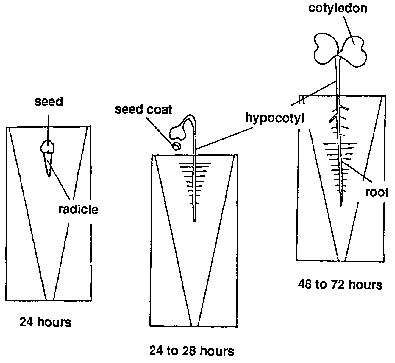
The radicle (embryonic root) emerges. Seedlings emerge from the soil. Two cotyledons (seed leaves) appear and the hypocotyl (embryonic stem) extends upward. Green (chlorophyll) pigment can be seen.
Growth and Development
Days 4-9: 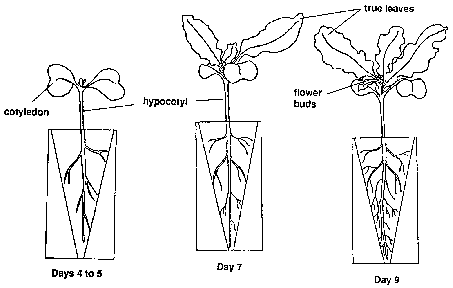
Cotyledons enlarge. True leaves emerge and develop. Flower buds appear in the growing tip of the plant.
Days 10-12:
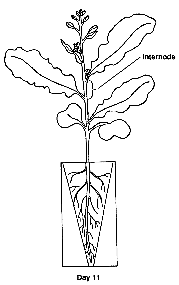
Stem elongates between the nodes (points of leaf attachment). Flower buds rise above the leaves. Leaves and flower buds continue to enlarge.
Flowering and Reproduction
Days 13-17:
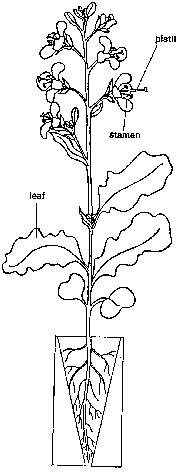
Flowers open. Floral parts can be identified. Flowers can be cross-pollinated (from one plant to another) for 3-4 days. Pollen is viable for 4-5 days and stigmas remain receptive to pollen for 2-3 days after a flower opens. After final pollination, prune off the remaining unopened flower buds and side shoots. Pruning directs the plant's energy into developing the seed.
Post-Pollination
Days 18-22:
Petals drop from the pollinated flowers. Pods elongate and swell. Development of the seed and embryonic plant has begun and will continue until approximately Day 36.
Days 23-36:
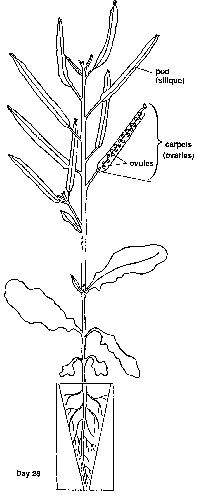
Seeds mature and ripen. Lower leaves yellow and dry. Twenty days after final pollination (about Day 36) plants should be removed from water.
Days 36-40:
Plants dry down and pods turn yellow. On Day 40, pods can be removed from dried plants. Seed can be harvested. The cycle is complete.
Life Cycle Concepts and Questions
Beginning the Life Cycle: Growth, Development and Flowering
Germination is the awakening of a seed (embryo) from a resting state. It involves the harnessing of energy stored within the seed and is activated by components in the environment. Growth represents increase in size, number and complexity of plant cells and organs. Environment and genetics play fundamental roles in regulating growth. The energy for growth comes from photosynthesis.
Flowering is the initiation of sexual reproduction. The generation of male and female gametes (sperm and eggs) is one of the primary functions in flowering. The plant prepares for pollination by producing flowers. Each part of the flower has a specific role to play in sexual reproduction. The flower dictates the mating strategy of the species.
- What are the main components of the environment necessary for germination?
- How does the seedling orient itself?
- What enables the emerging plant to shift its dependency from stored energy to the energy from light?
- What is the role of the environment in regulating plant growth?
- How do plants grow?
- How does a plant know when to produce leaves and when to produce flowers?
- Why does a plant have flowers?
Pollination
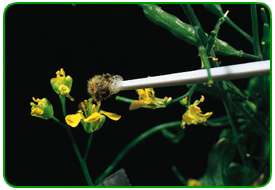
Pollination is the process of mating in plants. In flowers, pollen is delivered to the stigma through a wide range of mechanisms that insure an appropriate balance in the genetic makeup of the species. In brassicas, pollen is distributed by bees and other insects. The flower is the device by which the plant recruits the bee. Bees and brassicas have evolved an interdependent relationship.
- How do flower parts function to influence mating behavior?
- How does the flower recruit the bee?
- How does pollination occur?
- How does the flower discriminate between self and nonself in the mix of pollen?
Double Fertilization and Post-Fertilization Events
Fertilization is the final event in sexual reproduction. In higher plants, two sperm from the pollen grain are involved in fertilization. One fertilizes the egg to produce the zygote and begin the new generation. The other sperm combines with the fusion nucleus to produce the special tissue (endosperm) that nourishes the developing embryo. In some plants endosperm nourishes the germinating seedling. Fertilization also stimulates the growth of the maternal tissue (seed pod or fruit) supporting the developing seed.
- What is unique about fertilization in flowering plants?
- What is endosperm and what is its relationship to the embryo?
- How does an embryo develop into a seed?
- How does the maternal parent contribute to the developing
embryo?
|
![]()